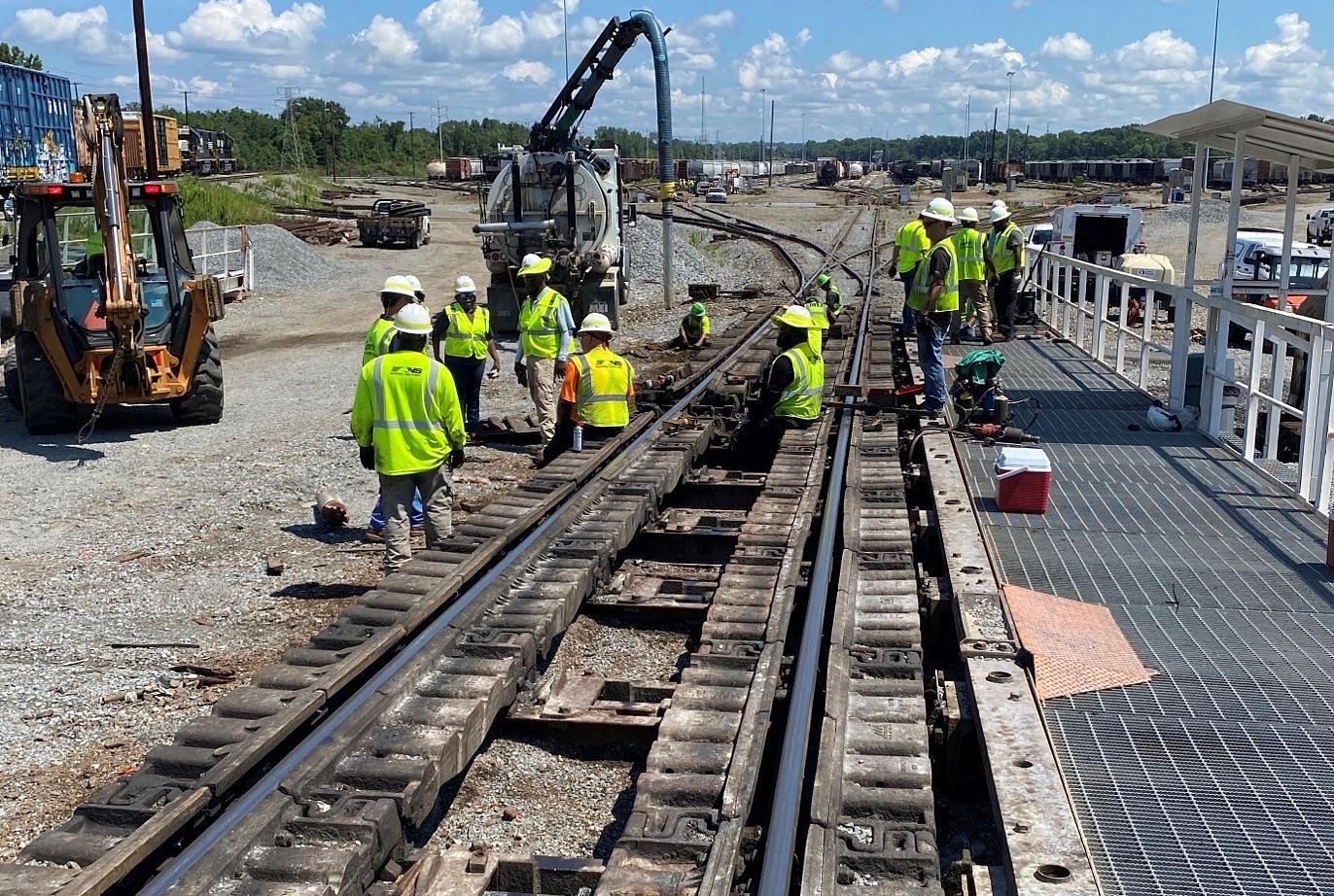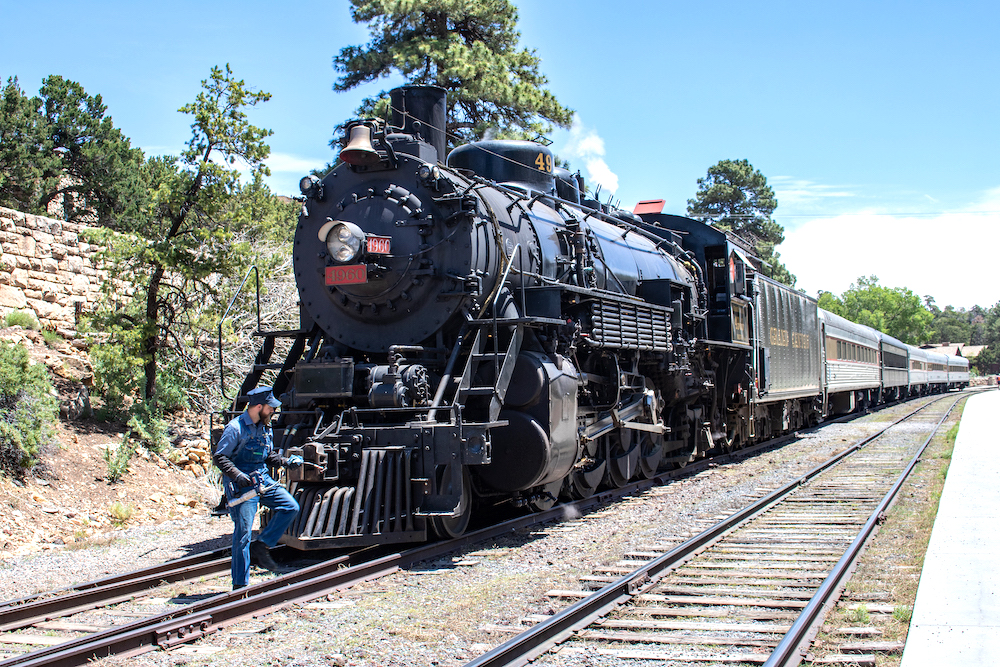Opened in 2002, the Alameda Corridor routes Union Pacific and BNSF Railway trains away from the ports on 20 miles of tracks with no at-grade crossings. Declining traffic “poses a severe financial risk” to the Alameda Corridor Transportation Authority, according to transportation consultant Mercator’s report to the Pacific Maritime Association.
It’s part of “a long term shift” of traffic leaving Los Angeles/Long Beach, intermodal consultant Larry Gross tells Trains.
The Alameda Corridor’s market share of Asian container traffic dropped from 56% in 2003 to 46% in 2018, the Mercator report says.
Also, large numbers of containers go directly to trucks and are drayed to local warehouses.
Gross says there is a slow trend of some freight being transloaded into domestic containers and “This results in a dray from the port to the Inland Empire for transloading and then the container hits the rail in San Bernadino or L.A. proper, avoiding the Alameda Corridor.”
Essentially, all authority revenue comes from user fees on containers moving by rail through the corridor.
“If the current trend continues [the authority] will experience significant cash flow deficits beginning in 2024, growing from $47 million per year from 2024 to 2029, to more than $100 million in 2029,” the Mercator report says. “Under this scenario, the accumulated shortfall would climb to $1.2 billion by 2038.”
The Alameda Corridor was constructed at a cost of $2.4 billion and continued revenue shortfalls could negatively affect the ratings of the authority’s bonds, says the Mercator report and a credit opinion by Moody’s Investor’s Service.
Increases in user fees that BNSF and Union Pacific pay the authority are restricted — the fees are indexed to inflation and range from between 1.5% to a limit of 4.5%, according to Moody’s.
Once fees are at the 4.5% ceiling, any revenue shortfall to the authority must be paid by the ports, Moody’s says.
The Mercator report says 94% of import containers through Los Angeles and Long Beach are from Asia and that the biggest threats are from expansions at the British Columbia ports in Prince Rupert and Vancouver.
Advantages of the Canadian ports for shipments to the Midwest are “transit time and dollar savings,” according to Gross.
Volume also is shifting from Los Angeles/Long Beach to the East Coast as a result of the 2016 completion of expansion of the Panama canal.
“Service issues, congestions, chassis shortages, land labor unrest are some of the contributing factors,” Gross says.
The U.S. Eastern and Gulf Coast ports have launched massive upgrade projects — including enlarged rail capacities — to lure Asian container traffic through the Panama Canal.
The upgrades have been paying off.
American Shipper reported last week that Los Angles suffered a 19% decrease in container traffic — the biggest in two decades — due to U.S. trade policies.
“Now, with the China trade war, sources are shifting away from China towards Southeast Asia points which are just as likely to come to the U.S. west through the Suez Canal versus east to the U.S. West Coast,” Gross says.
And Gulf Coast ports are benefitting from shippers abandoning intermodal for all-water routes “being driven by the rise of resin exports from the Gulf Coast refineries driven by fracking and the availability of cheap natural gas,” he says.














Another reason why the Class I’s if they have any sense is to get competitive and go after single car business.
Paul I do know sometime back the Ports of LA/LB were in talks with BNSF, and UP for a shuttle service, not sure what has became of it, but yes they do need to figure something out. I’d also like to know what’s going on with BNSF’s proposed South Gateway ICTF.. Perhaps they could entice future/proposed DC’s to locate closer to the port
Gerald that’s another reason they like the near port DCs. No long empty ocean box backhaul.
I have been wondering how CN has been able to get away with that. Maybe the lower port costs and the shorter boat ride saves enough $$$ to allow it.
One of the biggest issues is with the Longshoreman’s Union on the West Coast…they work very little for exhorbitant pay and have so many days off it’s not funny. Plus they like to strike or take work stoppages at the drop of a pin…and that’s been going on for almost 30 years +. It caused issues when I worked for an Intermodal Marketing company, though I think they may have wisened up a little lately and curtailed some of the work stoppages I know it was a major issue…and a big reason for the cost at the Ports on West Coast of the U.S.
There’s also an imbalance of imports/exports in regards to transloading, you have more product going East than you do West and so empties are always being moved Westbound empty…where as the steamship lines offer cheap rates to move their 20′, 40′ and 45′ containers Westbound after being delivered Eastbound…this doesn’t help with products that weigh out before they cube out.
Braden I think the problem is you can’t charge more than the drayman, and that probably doesn’t cover the rail cost including a full crew, the frequent train starts required to achieve the decongestant benefits and close to dray equivalent service, and the lift cost at the far Inland Empire ramp end.
SCIG opposition is mostly NIMBY ridiculousness. I say mostly because the projected reduction in *overall* air quality impacts and congestion from fewer truck trips to/from the ports imore than offsets any additional impacts from idling locomotives. But it does shift truck traffic impacts so very local impacts may be different.
Finally DCs near the ports is an interesting idea and not preposterous, but real estate costs and brownfields impacts also impede. Plus those facilities in the Inland Empire are huge, and assembling enough parcels in the LA/LB port district and nearby Carson and Torrance isn’t trivial.
I know UP tried to institute domestic IM service from Dolores Yard near the port a year or two back (can’t recall), but unsure how that’s panned out.
I presume the railroads are paying the “fee”, to compete with trucks paying nothing to contribute towards the local roads they are running on .
Eventually you would think a carbon tax and a move to electrification , plus conjestion pricing would favor the Railroad.
As I’ve been saying for awhile, this corridor needs to be repurposed (or half purposed) for “mine run style” shuttles of ocean containers “just off the ship” bound for Inland Empire ramps (UP needs one, BNSF needs to expand theirs in San Bernardino) where they either take a short dray to the many Distribution Centers for transfer into 53s.
Since this short haul doesn’t pay for the railroad, a subsidy is required. This can come from a variety of sources, chiefly from the ports, who gain considerable advantages in throughput, reduced storage space for staging boxes for trucks, less truck congestion in the port, reduced lift count (ship to train instead of ship to ground and ground to chassis), and much better chassis utilization. But also from the local governments in terms of air quality and freeway congestion from all the Inland Empire drays eliminated.
On dock rail plus the Alameda Corridor in place is what facilitated it. Train loads could be preblocked for local Inland Empire offloading or further inland penetration to medium haul western markets by rail where “less than trainload” blocks of ocean boxes can ride manifest freights or other domestic Z trains to places like Vegas, Phoenix, SLC, Denver and the Bay Area at low cost to the rail.